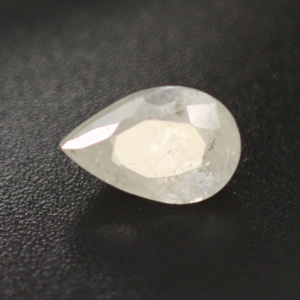Powellite

Powellite
(Pear cut. From India. 0.68 carat; 6.3 x 4.2 x 3.3mm)
Image © supplied by Freakingcat Gems
Powellite History & Etymology:
Powellite is extremely rare and were first discovered in 1891 in the Pandeluna Hill in the district of Nashik in the state of Maharashtra in India. Powellite was first discovered by John Wesley Powell, the famous American geologist and explorer.
Powellite hence derive their name from the American explorer John Powell who discovered them. Before the chance discovery of Powellite the Powellite gemstones were virtually unknown but now they are among the most sought after rare gemstones by the gemstone collectors.
Powellite Occurrence:
Powellite gemstones are found mainly in the Pandeluna Hill in the Nashik district in the state of Maharashtra, India. Apart from this locality, Powellite is also found in the Peacock Mines in Cuprum in the district of Seven Devils in Adams County in Idaho, USA. However gemstone quality crystals of Powellite are only found in Maharashtra, India.
Powellite crystals are extremely small, making faceting difficult. Hence gemstones of Powellite are also extremely rare. Powellite is generally transparent with extremely high dispersion.
Powellite Properties:
Powellite is composed of calcium molybdenate. The Powellite mineral is hence classified as wolframates and molybdates minerals. Powellite belongs to the Powellite-Scheelite Series.
Powellite displays tetragonal and dipyramidal properties and the Powellite crystals display dipyramidal crystal habit in their natural form. The crystalline masses of Powellite are usually tabular and sometime paper thin with numerous minor formations. The crystalline masses of Powellite are at least 8 cm in size. The crystalline masses of Powellite also occur as aggregates with are segregated by crusts.
Twinning in the Powellite crystals is not observed. The cleavages on the Powellite are indistinct with uneven fracturing. The indistinct cleavages coupled with uneven fracturing makes the Powellite crystals quite brittle. The Moh’s hardness for Powellite is between 3.5 and 4. Powellite is relatively dense with a density of approximately 4 g/cm3. Powellite also displays properties of luminescence. Powellite display fluoresces with a creamy white color to yellow and sometimes golden yellow coloring under UV light of short wavelength. Powellite are however not radioactive.
Powellite occurs in a wide range of colors. Powellite are usually colorless, greenish yellow and straw yellow in color. Powellite also occur in the colors of brown and yellowish brown. But such Powellite crystals are extremely rare. Powellite are generally transparent but inclusions in some crystals cause them to appear translucent.
Powellite displays sub-admantine luster which gradually changes to a resinous shine and finally changes to a pearly shine on the edges. The refractive index of the Powellite crystals varies between 1.97 and 1.98 while the birefringence of the Powellite crystals is at 0.01. The dispersion in the Powellite crystals is at 0.058 which is much higher than the dispersion in diamonds.
Powellite is very rarely faceted.
Back to the Gemstones List home page - over 160 gemstones explored!
Sources Referenced:
[1]
Please feel free to link to this page - copy / paste the text below: (click to select)
Privacy Policy | Cookie Policy | GDPR | About This Site / Terms

© gemstoneslist.com 2018


